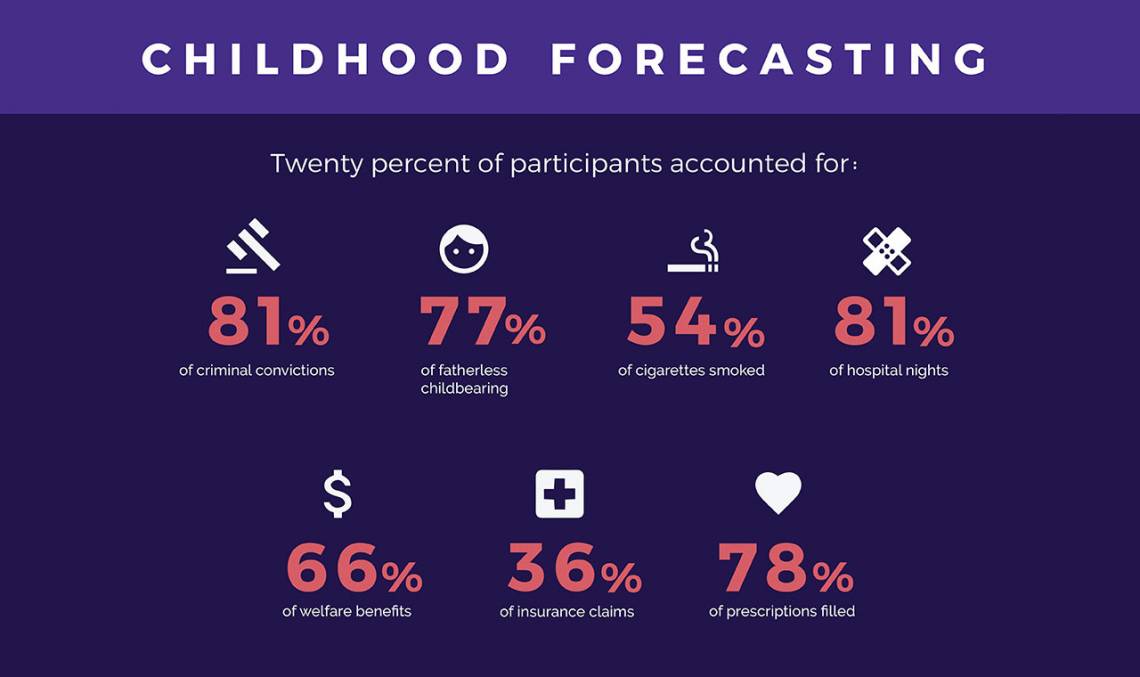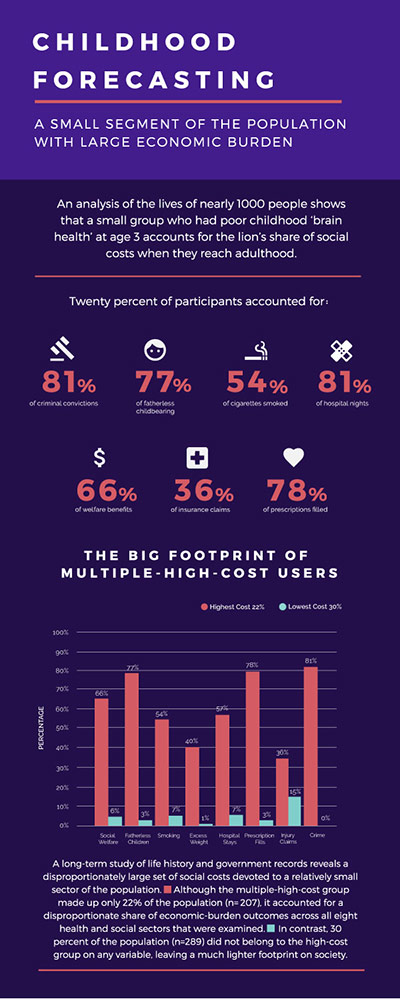Adults With the Most Costly Problems Could Be Spotted in Preschool
Study finds the “80/20 Rule” applies to social costs

A detailed analysis of the lives of nearly a thousand people from birth to age 38 shows that a small portion of the population accounts for the lion’s share of social costs such as crime, welfare dependence and health-care needs as adults.
Just one-fifth of the study population accounted for 81 percent of criminal convictions and 77 percent of fatherless childrearing. This fifth of the group also consumed three-quarters of drug prescriptions, two-thirds of welfare benefits and more than half of the hospital nights and cigarettes smoked.
The researchers found they could have predicted which adults were likely to incur such costs as early as age 3 based on assessments of “brain health,” giving them hope that early interventions could avoid some of these social costs.
 Graphic by Jonathan Fuller/Duke Office of News and Communications.
Graphic by Jonathan Fuller/Duke Office of News and Communications.The analysis, by researchers at Duke University, King’s College London and the University of Otago in New Zealand, combined data from a long-term study of a group of people born in the same year in Dunedin, New Zealand with their electronic health records and governmental databases on such things as health, welfare and criminal justice. (See graphic left. A larger version can be found here.)
The research group wanted to test the “Pareto principle,” which is also called the “80-20 rule.” Italian engineer and social scientist Vilfredo Pareto observed a century ago that 80 percent of wealth is controlled by 20 percent of the population. This principle has subsequently been found a useful rule of thumb when applied to phenomena in computer science, biology, physics, economics and many other fields.
The composite statistical picture the researchers created of this group shows that the most socially “costly” 20 percent of the study participants also carried 40 percent of the kilograms of obese weight and filed 36 percent of personal-injury insurance claims.
“Most expenses from social problems are concentrated in a small segment of the population,” said Avshalom Caspi, Edward M. Arnett professor of psychology & neuroscience and psychiatry & behavioral sciences at Duke. “So whatever segment of the health, social or judicial system that you look at, we find a concentration. And that concentration approximates what Pareto anticipated over 100 years ago. We called the group 'high-needs/high-costs’.”
The researchers acknowledge that it would be difficult to replicate the Pareto principal in social costs without this rare life-long study and very good public records.
“Other researchers were skeptical about whether it is possible to make an accurate match between public records and individuals taking part in a life-long study, but New Zealand’s national databases are very reliable and Dunedin Study members have given us great information for matching over the years,” said Terrie Moffitt, the Nannerl O. Keohane University Professor in Duke’s departments of psychology & neuroscience and psychiatry & behavioral sciences. “We know every location they’ve lived, every name they’ve used. We’re able to match them with pretty much 100 percent accuracy back for many years.”
“The digitization of people’s lives allows us to quantify precisely how much a person costs society and which people are using multiple different costly health and social services,” Moffitt said. “Apparently, the same few clients use the courts, welfare benefits, disability services, children’s services, and the health-care system. These systems could be more joined up.”
The key information the researchers possessed was rich data about the study group in early childhood.
At age 3, each child in the study had participated in a 45-minute examination of neurological signs including intelligence, language and motor skills, and then the examiners also rated the children on factors such as frustration tolerance, restlessness and impulsivity. This yielded a summary index the researchers called “brain health.”
In the latest study, low scores on the brain health index at age 3 were found to predict high healthcare and social costs as an adult. “We can predict this quite well, beginning at age 3 by assessing a child’s history of disadvantage, and particularly their brain health,” Caspi said.
The findings remind Rena Subotnik, director of the Center for Psychology in Schools and Education for the American Psychological Association, of a recent effort in New Jersey to put a medical clinic in the neighborhood with the greatest need for services.
Educators might be able to do the same sort of thing for these young children at risk of higher social costs, she said. “These are all traits that can be controlled and improved upon with the proper interventions, so identifying them in young children is a gift,” she said. And all of society would benefit. “You get the best bang for the buck with early intervention,” Subotnik said.
Caspi and Moffitt stress that this ability to identify and predict a person’s life course from their childhood status should be an invitation to intervene, not discriminate.
“Any time you identify a population segment, the next thing people do is stigmatize,” Moffitt warned. But being able to predict which children will struggle is an opportunity to intervene in their lives very early to attempt to change their trajectories – “for everyone’s benefit,” Moffitt said. “This study really gives a pretty clear picture of what happens if you don’t intervene.”
“There is a really powerful connection from children’s early beginnings to where they end up,” Caspi said. “The purpose of this was not to use these data to complicate children’s lives any further. It’s to say these children -- all children -- need a lot of resources, and helping them could yield a remarkable return on investment when they grow up.”
The study was funded by US National Institute on Aging (NIA) grants AG032282, AG048895, AG049789 and UK Medical Research Council (MRC) grant MR/K00381X and ESRC grant ES/M010309/1. The Dunedin Study is supported by the New Zealand Health Research Council and New Zealand Ministry of Business, Innovation and Employment (MBIE). Additional support was provided by the Jacobs Foundation and the Avielle Foundation.
CITATION: “Childhood Forecasting of a Small Segment of the Population With Large Economic Burden,” Avshalom Caspi, Renate Houts, Daniel Belsky, Honalee Harrington, Sean Hogan, Sandhya Ramrakha, Richie Poulton, Terrie Moffitt. Nature Human Behaviour. Dec. 12, 2016. DOI: 10.1038/S41562-016-0005